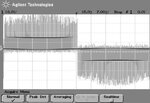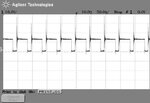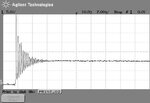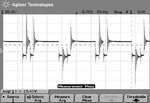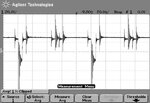thelukuntla
Junior Member level 1
hi
I am making a single-phase inverter with a dc-dc boost converter for my project and with an aim to make it to 1 kw rating and 230 V, 50Hz rms using dc power supply in the lab with 175V and 10A supply.
I followed guidelines given in 6N136, IR2110 and AN-978 , DT97-3 datasheets and kept Rgon=15 Ω and Rgoff=8.2Ω using anti-parallel diode across Rgon and made individual driver circuits for all switches.
MOSPETS used : STW20NK50Z
Switching frequency: 10KHz
PWM pattern: Sine
Initially i made the inverter circuit and tested with low input dc voltage around 12V and measured output of inverter circuit i found still ringing effect and switching noise more than double the input dc voltage. some screen shots of output waveform are given as attachments.
I made separate high side drivers for all MOSFETS (4 no.s) of single-phase inverter. Optocoupler and IR2110 driver portion of the circuit is on PCB and rest inverter portion of switches are mounted on separate board, connection between driver output to gate and source terminals of MOSFETS done by using wires of around 10-15 cms in length.I kept bootstrap capacitors with 4.7μF and 10 μF for high side and low side of IR2110.
As my power circuit ground is different from driver circuit ground, so i kept 4 no. separate high side drivers to drive each MOSFET and using only high side part of the IR2110 IC.
let me know where i am doing mistakes.
Thanks in advance.
Chandra Shekar
I am making a single-phase inverter with a dc-dc boost converter for my project and with an aim to make it to 1 kw rating and 230 V, 50Hz rms using dc power supply in the lab with 175V and 10A supply.
I followed guidelines given in 6N136, IR2110 and AN-978 , DT97-3 datasheets and kept Rgon=15 Ω and Rgoff=8.2Ω using anti-parallel diode across Rgon and made individual driver circuits for all switches.
MOSPETS used : STW20NK50Z
Switching frequency: 10KHz
PWM pattern: Sine
Initially i made the inverter circuit and tested with low input dc voltage around 12V and measured output of inverter circuit i found still ringing effect and switching noise more than double the input dc voltage. some screen shots of output waveform are given as attachments.
I made separate high side drivers for all MOSFETS (4 no.s) of single-phase inverter. Optocoupler and IR2110 driver portion of the circuit is on PCB and rest inverter portion of switches are mounted on separate board, connection between driver output to gate and source terminals of MOSFETS done by using wires of around 10-15 cms in length.I kept bootstrap capacitors with 4.7μF and 10 μF for high side and low side of IR2110.
As my power circuit ground is different from driver circuit ground, so i kept 4 no. separate high side drivers to drive each MOSFET and using only high side part of the IR2110 IC.
let me know where i am doing mistakes.
Thanks in advance.
Chandra Shekar
